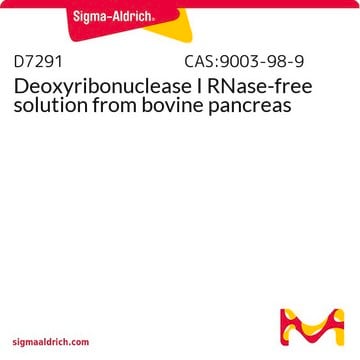10104159001
Roche
DNase I
grade II, from bovine pancreas
Synonym(s):
Deoxyribonuclease, Deoxyribonucleate 5′-oligonucleotido-hydrolase
Sign Into View Organizational & Contract Pricing
All Photos(1)
About This Item
UNSPSC Code:
12352204
Recommended Products
biological source
bovine pancreas
Quality Level
form
lyophilized
packaging
pkg of 100 mg
manufacturer/tradename
Roche
technique(s)
DNA extraction: suitable
optimum pH
~7.0
storage temp.
2-8°C
General description
Bovine pancreatic deoxyribonuclease I (DNase I) is a DNA minor grove-interacting nuclease which shows relatively low specificity. This protein is composed of two central β sheets, each composed of six β-strands. This structure is surrounded by extensive loop and α-helical regions. This enzyme shares structural similarity to exonuclease III. DNase I is one of the most well characterized endonucleases of mammalian origin. It is a double-strand-specific endonuclease that requires bivalent cations for maximal activity.
Application
Isolation procedures for proteins (e.g., membrane proteins).
Bovine pancreatic deoxyribonuclease I (DNase I) has been used for-
Bovine pancreatic deoxyribonuclease I (DNase I) has been used for-
- The isolation of cells from lung, skin and tumor samples
- Bacterial DNA extraction from live bacterial cells that are resistant to DNase I †
Unit Definition
One unit is the enzyme activity that causes an increase in the absorbance of 0.001 per minute under assay conditions.
Preparation Note
Activator: Ca2+ (0.12 mM) in combination with Mg2+ enhances activity [Laskowski (1971); Melgar and Goldthwait (1968)].
Working concentration: 1 mg/ml
Do not vortex while dissolving!
Storage conditions (working solution): Reconstituted in water, the solution can be kept for 2 to 3 days at 2 to 8 °C. Do not vortex during dissolving. Note: Dissolve at least 1 mg/ml.
Working concentration: 1 mg/ml
Do not vortex while dissolving!
Storage conditions (working solution): Reconstituted in water, the solution can be kept for 2 to 3 days at 2 to 8 °C. Do not vortex during dissolving. Note: Dissolve at least 1 mg/ml.
Other Notes
For life science research only. Not for use in diagnostic procedures.
signalword
Danger
hcodes
Hazard Classifications
Resp. Sens. 1 - Skin Sens. 1
Storage Class
11 - Combustible Solids
wgk_germany
WGK 1
flash_point_f
does not flash
flash_point_c
does not flash
Choose from one of the most recent versions:
Already Own This Product?
Find documentation for the products that you have recently purchased in the Document Library.
Customers Also Viewed
M Salimi et al.
Clinical and experimental dermatology, 41(5), 552-556 (2016-01-26)
Studying skin immune cells under various pathophysiological conditions is vital for understanding the nature of cutaneous inflammatory responses. Available methods of isolating cells from the skin have relatively low yield or require in vitro culture. To increase the effective isolation
Alejandro A Pezzulo et al.
Applied and environmental microbiology, 79(19), 5936-5941 (2013-07-23)
Human lungs are constantly exposed to bacteria in the environment, yet the prevailing dogma is that healthy lungs are sterile. DNA sequencing-based studies of pulmonary bacterial diversity challenge this notion. However, DNA-based microbial analysis currently fails to distinguish between DNA
Mitsuteru Natsuizaka et al.
American journal of cancer research, 4(1), 29-41 (2014-02-01)
Insulin-like growth factor binding protein 3 (IGFBP3), a hypoxia-inducible gene, regulates a variety of cellular processes including cell proliferation, senescence, apoptosis and epithelial-mesenchymal transition (EMT). IGFBP3 has been linked to the pathogenesis of cancers. Most previous studies focus upon proapoptotic
S Cal et al.
The EMBO journal, 17(23), 7128-7138 (1998-12-08)
Bovine pancreatic deoxyribonuclease I (DNase I) is a nuclease of relatively low specificity which interacts with DNA in the minor groove. No contacts are made between the protein and the major groove of the nucleic acid. DNase I is structurally
Yanhui Cai et al.
Journal of immunology (Baltimore, Md. : 1950), 192(6), 2821-2829 (2014-02-19)
Alveolar macrophages (AMs) obtained by bronchoalveolar lavage (BAL) are commonly used to study lung macrophage-mediated immune responses. Questions remain, however, about whether AMs fully represent macrophage function in the lung. This study was performed to determine the contribution of interstitial
Our team of scientists has experience in all areas of research including Life Science, Material Science, Chemical Synthesis, Chromatography, Analytical and many others.
Contact Technical Service














